Areopagus Hill is a rocky monolith, 115 meters high, right across from Acropolis Hill in Athens. It has a significant ancient history as it was the prominent judicial court of Athens. Centuries later, Apostle Paul delivered his powerful sermon about the ‘Unknown God’ on the same rock.
While the Acropolis, Philopappou, Pnyka Hills, and the vast residential 360-degree view of Athens steal the show when you reach the top, Areopagus offers a different kind of magic. As the sun dips behind Mount Aigaleo in western Athens, the hill transforms into a popular romantic spot, bathed in a warm glow.
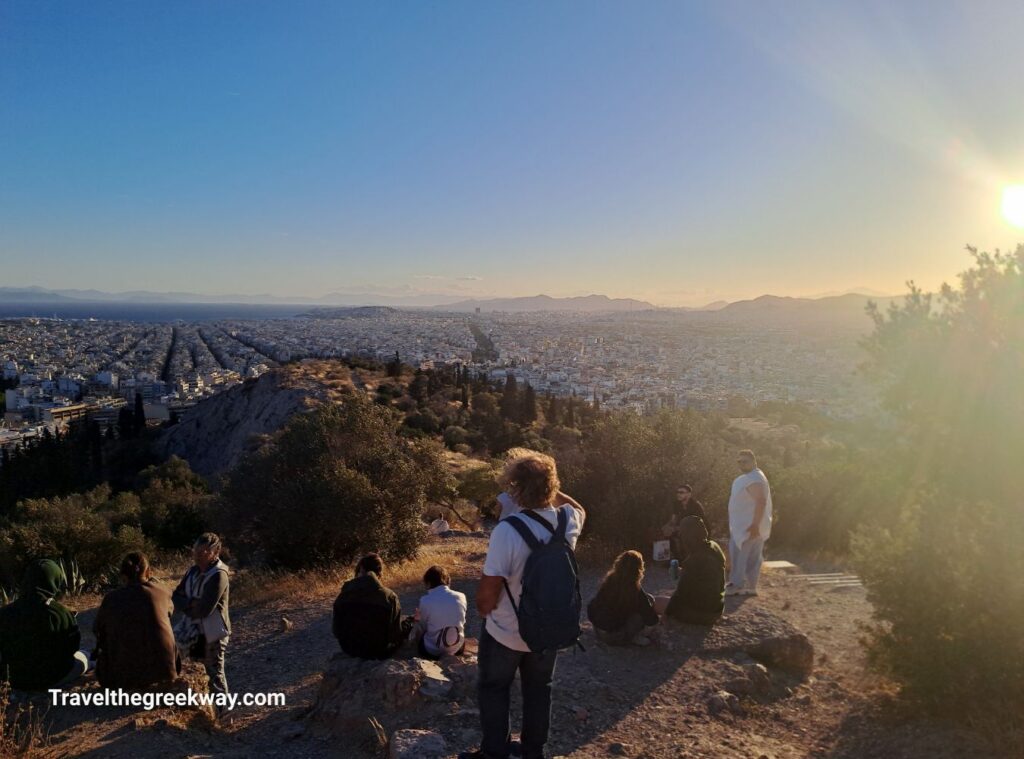
But enough about the view! Let’s delve deeper into the meaning behind the name “Areopagus” (or Mars Hill as the Romans used to call it), explore its fascinating history, uncover the reason for Apostle Paul’s visit, and provide tips for navigating its slippery terrain.
*Some of the links below are affiliate links. That means I may make a commission if you click and buy. The commission comes at no additional cost to you.
My Latest Video on Areopagus Hill
If you are wondering what Areopagus, means, it is basically, a union of two ancient Greek words:
- Αreios, an adjective referring to the god of war Ares, and
- Pagos, which the ancient Greeks used to describe any large and bare rock.
You will also find the hill under the name of Mars, which is the name of the god Ares in Latin.
History of Areopagus Hill
Significant Milestones in the History of the Areopagus are:

- There is evidence that Areopagus was used as a court location that dealt with murder cases, during the Mycenean Era of Athens, around 1500 to 1300 BCE, back in the days of Cecrops and Theseus.
- According to Pausanias, a famed Greek traveler and writer (110 – 180 CE), the hill’s role in settling disputes dates back to the mid-7th century BCE, during the First Messenian War. This is more than two centuries before Classical Athens and the construction of the Temples in Acropolis.
- Prominent male Athenians constituted the Areopagus body, one of the most prestigious and politically powerful institutions in Athens. Areopagus Hill served as a venue for judicial proceedings, specifically for the Council of the Areopagus, whose jurisdiction, after 462 BCE, included the trial of premeditated murders, arson, and blasphemy.
- The Hill continued to function when the Romans conquered Athens (86 BCE) and served as an important meeting place where philosophy, religion, and law were discussed.
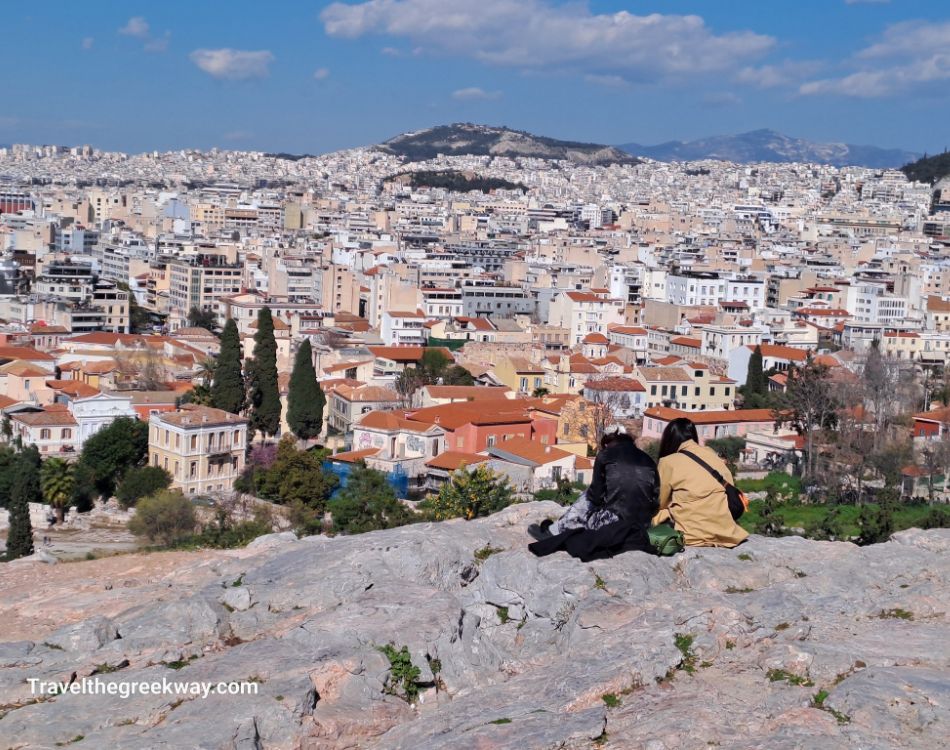
- At the foot of the Areopagus was a temple dedicated to the Erinyes, where murderers could find sanctuary. Erinyes or furies were female chthonic deities of vengeance in ancient Greek religion and mythology. A famous Chtonic ritual was the Eleusinean Mysteries.
- The Areopagus ceased operation as a political council by at least the early 5th century CE, according to Theodoret of Cyrus, a theologian (393-458 CE).
- On October 16, 1834, a royal decree was published, establishing the Supreme Court of the newly formed Greek State, officially named Areopagus after the ancient tribunal of the same name.
Apostle Paul’s Sermon in Athens

A few meters before you reach the steps for the Areopagus hill, you will notice a bronze plaque on the wall. It is inscribed in Greek and features Apostle Paul’s gospel presentation during his visit to Athens on his second missionary journey (49 CE).

When Paul arrived in Athens he found a city “given over to idols”. He preached the gospel to Jews and Gentiles in the Ancient Agora of Athens and the Jewish Synagogue. There, he encountered Epicurean and Stoic philosophers who were curious about “this new religion” and they “brought him to the Areopagus” to hear more.

Apostle Paul mentioned those altars dedicated to the “Unknown god” that Athens had plenty of. He talked about how God would judge the world through a man who rose from the dead. This statement provoked sarcastic comments from the Athenians who scoffed him. However, two of the listeners, Dionysios Areopagitis – who is today Athens’ patron saint – and Damaris, were converted to Christianity.
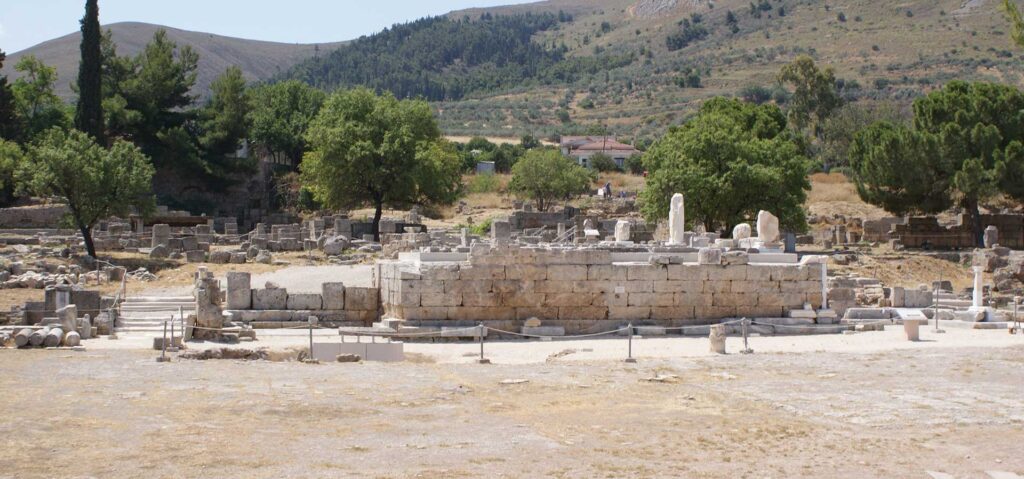
After Athens, Apostle Paul traveled to Corinth, where he stayed for a year and a half and wrote the Thessalonian Epistles. He then journeyed from Corinth, departing through the ancient port of Kechries, on his way to Ephesus.
Apostle Paul’s part of his original sermon:
“Άνδρες Αθηναίοι… διερχόμενος γαρ και αναθεωρών τα σεβάσματα υμών εύρον και βωμόν εν ω επεγέγραπτο, αγνώστω Θεώ (unknown God). Ον ουν αγνοούντες ευσεβείτε, τούτον εγώ καταγγέλλω υμίν… τίνες δε άνδρες κολληθέντες αυτώ επίστευσαν, εν οις και Διονύσιος ο Αρεοπαγίτης…”
Mythology and Areopagus
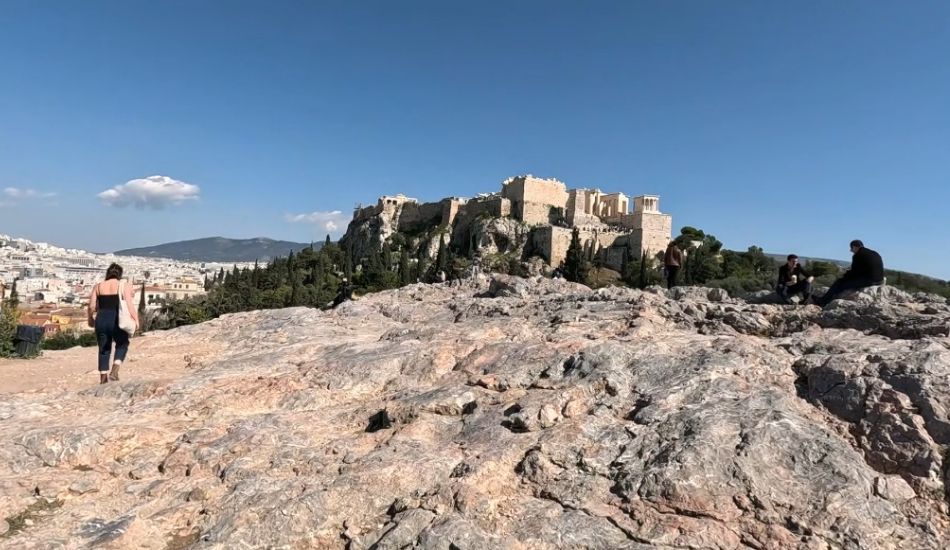
In Greek mythology, you will read that Ares (the god of war) faced trial among the twelve gods at this location for the killing of Alirrothios, Poseidon’s son. Alirrothios had tried to rape Alcippe, the daughter of Ares but was caught red-handed by Ares.
Another tale suggests that the hill served as the venue for the trial of Orestes, who was charged with the murder of his stepmother, Clytemnestra, and her lover, Aegisthus in the Mycenaean Palace in the Peloponnese. However, Orestes was acquitted by goddess Athena’s favorable vote.
What to Do on Areopagus Hill
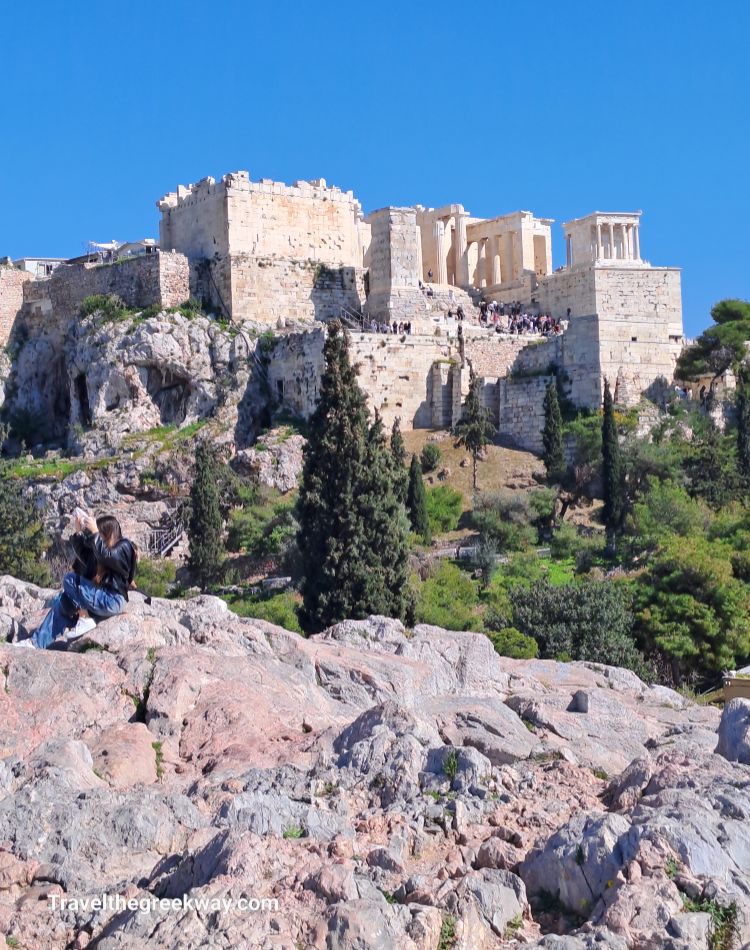
The best thing to do on Areopagus Hill is to take in all the incredible views, especially at sunset! You get great unobstructed views of the city below and it is a nice photo opportunity for the Acropolis as well.
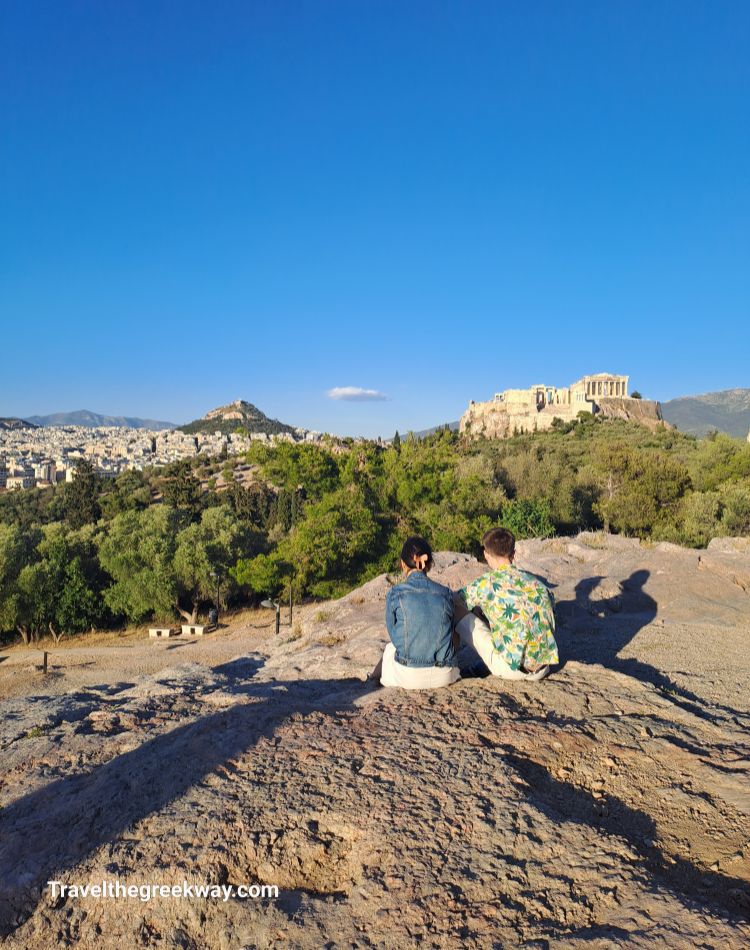
From Areopagus, you can walk downhill towards the pedestrian of Thision area that will guide you to the Pnyx, observatory, and other cool spots. Climb to the top of Pnyx Hill for an awesome Acropolis view and walk to the Philopappou Hill.
Tips about Visiting Areopagus

- During summer the hill will be crowded and too hot to stay for more than a short time. I suggest you visit it the earliest possible or for a nice sunset go after 7.30 but never in the dark as in certain areas it is very slippery with minimum light.
- Wear flat shoes with a good grip and use the modern metal staircase.
- Areopagus Hill is always open and the entrance is free of charge.

The last time I visited (April 2024) I was a bit disappointed by the numerous cigarette butts and the graffiti spoiling a significant Athenian monument. I am aware that the Athens municipality does clean the place but as it is open and free for everyone to go, people do not respect Areopagus as they should.

However, keep as a last thought, that this is a wonderful place to be in Athens: for its history, its religious significance to Christianity and for the lovely feeling of being high above Athens, an ancient and modern vibrant city!
Which are the Best Areas to Stay in Central Athens?
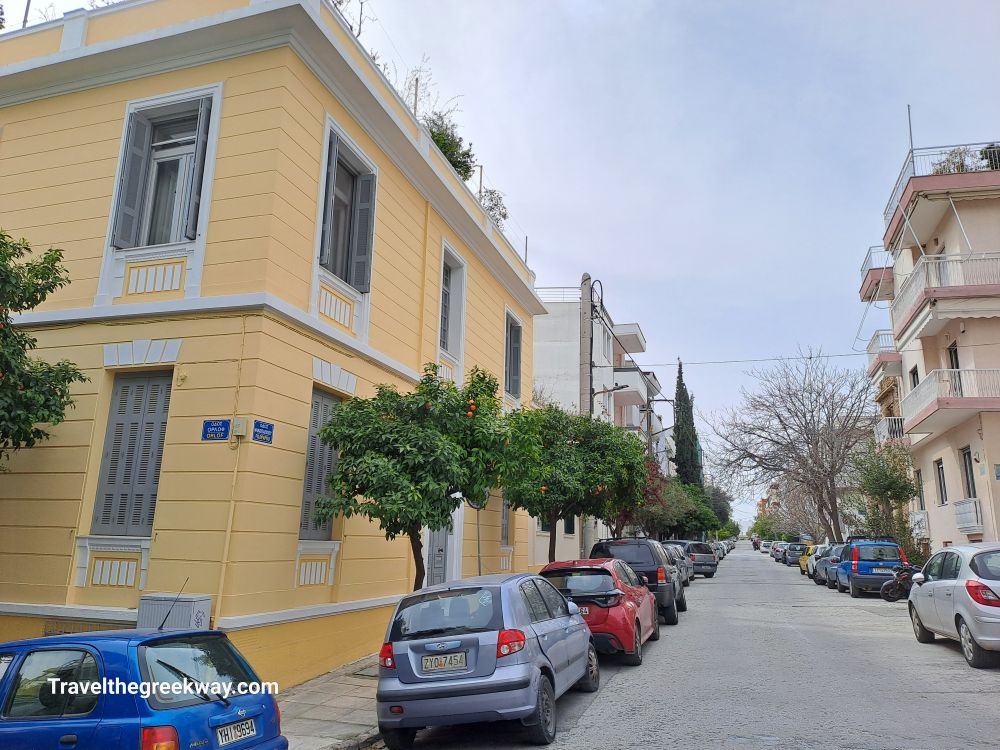
Athens offers a variety of neighborhoods, each with its own unique charm and attractions. I live in central Athens toward the north, a very residential neighborhood. However, if you are visiting Athens for a short period some of the best areas to stay in central Athens are:
- Plaka is the oldest and most picturesque neighborhood in Athens.
- Koukaki is a trendy and vibrant neighborhood.
- Syntagma is the central square of Athens with the Hellenic Parliament, a constant bustling hub of activity.
- Monastiraki is a bustling district known for its flea market, street art, and lively atmosphere.
- Psyrri is a lively hub of art, culture, and nightlife area.
- Kolonaki is an upscale neighborhood known for its high-end boutiques, art galleries, and gourmet restaurants.
- Exarchia is a unique and energetic quarter in Athens, known for its alternative culture, political activism, and bohemian atmosphere. It is often described as the city’s “anarchist quarter.” The exceptional National Archaeological Museum is in the area.
- Beachfront hotels in Athens by the Athens Riviera.
- Hotels near the Athens Airport.
I hope you enjoyed this article and I convinced you to visit Areopagus. Until next time, Happy travels! Evgenia.
Essential Travel info for Greece
- ‘Hello’ and ‘Thank You’ in Greek: “Ya sou” and “Efharisto”
- Booking.com: I use Booking.com mostly for Europe. It has over 1 Million properties to choose from, including everything from hotels to apartments and even hostels. And free cancellation!
- Expedia: I use Expedia for the best hotel descriptions and amenities and a rewards points system for the rest of the world.
- All-Inclusive Resorts in Greece
- FerryScanner to book ferries to the Greek Islands
- Rent an Affordable Car in Greece
- Athens Metro Website (timetables and ticket info)
- Map of Athens Metro
- Trains (Hellenic Train)
- Public Buses KTEL
- Get Your Guide: For all your day or multi-day tours and city guide needs, I use Get Your Guide
- Emergency Numbers Anywhere in Greece: AMBULANCE 166 – FIRE 199 – POLICE 100– EMERGENCY NUMBER 112
